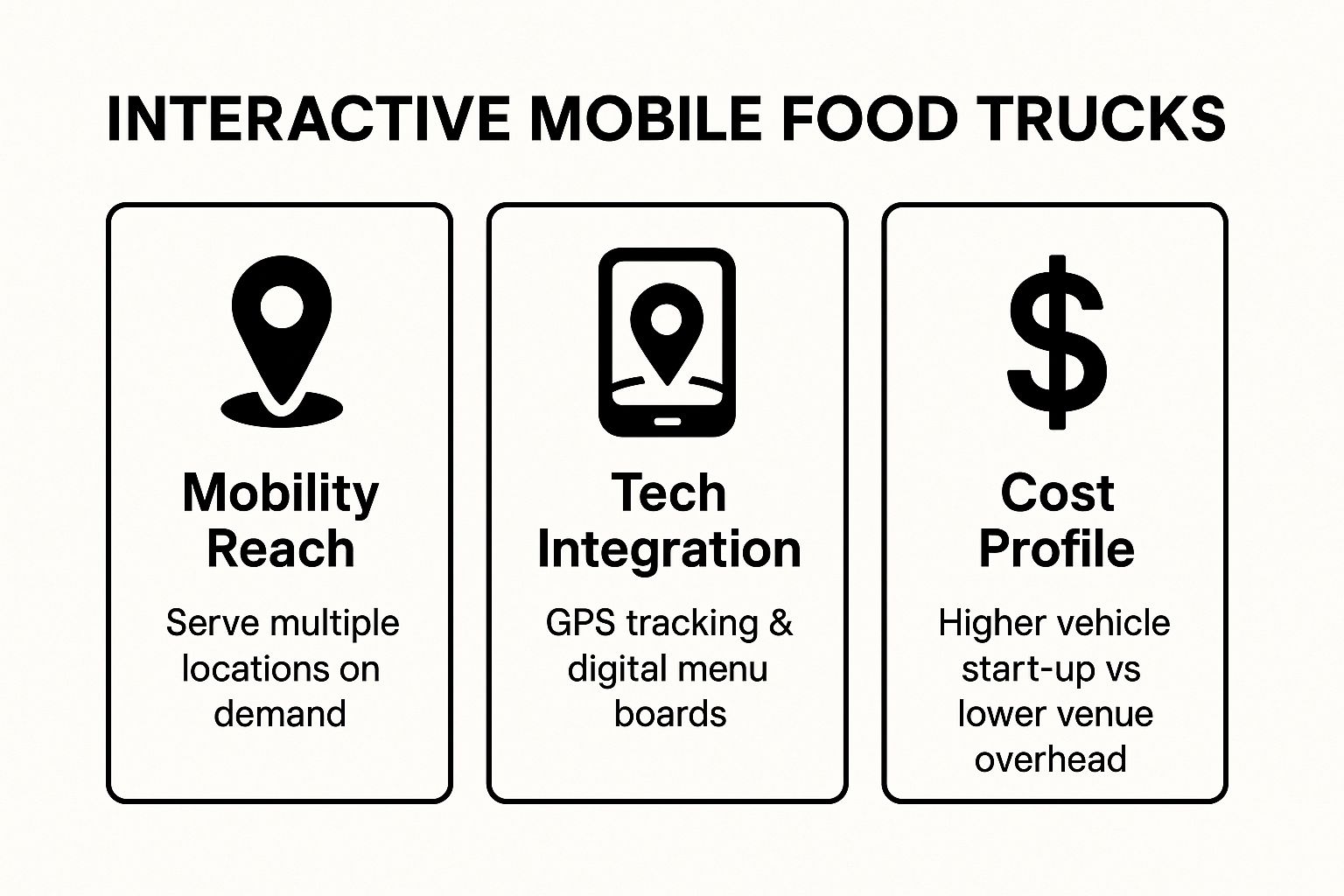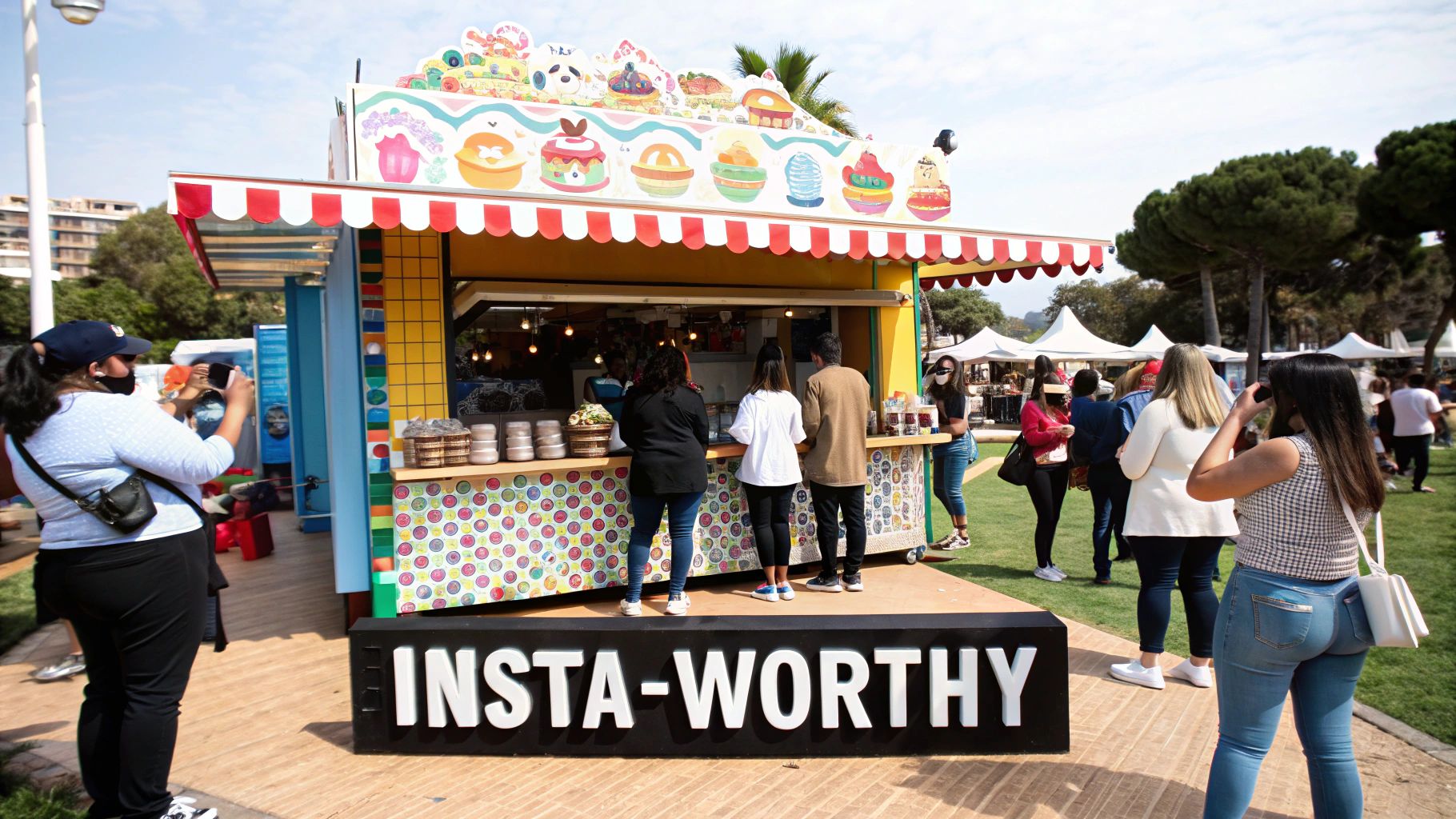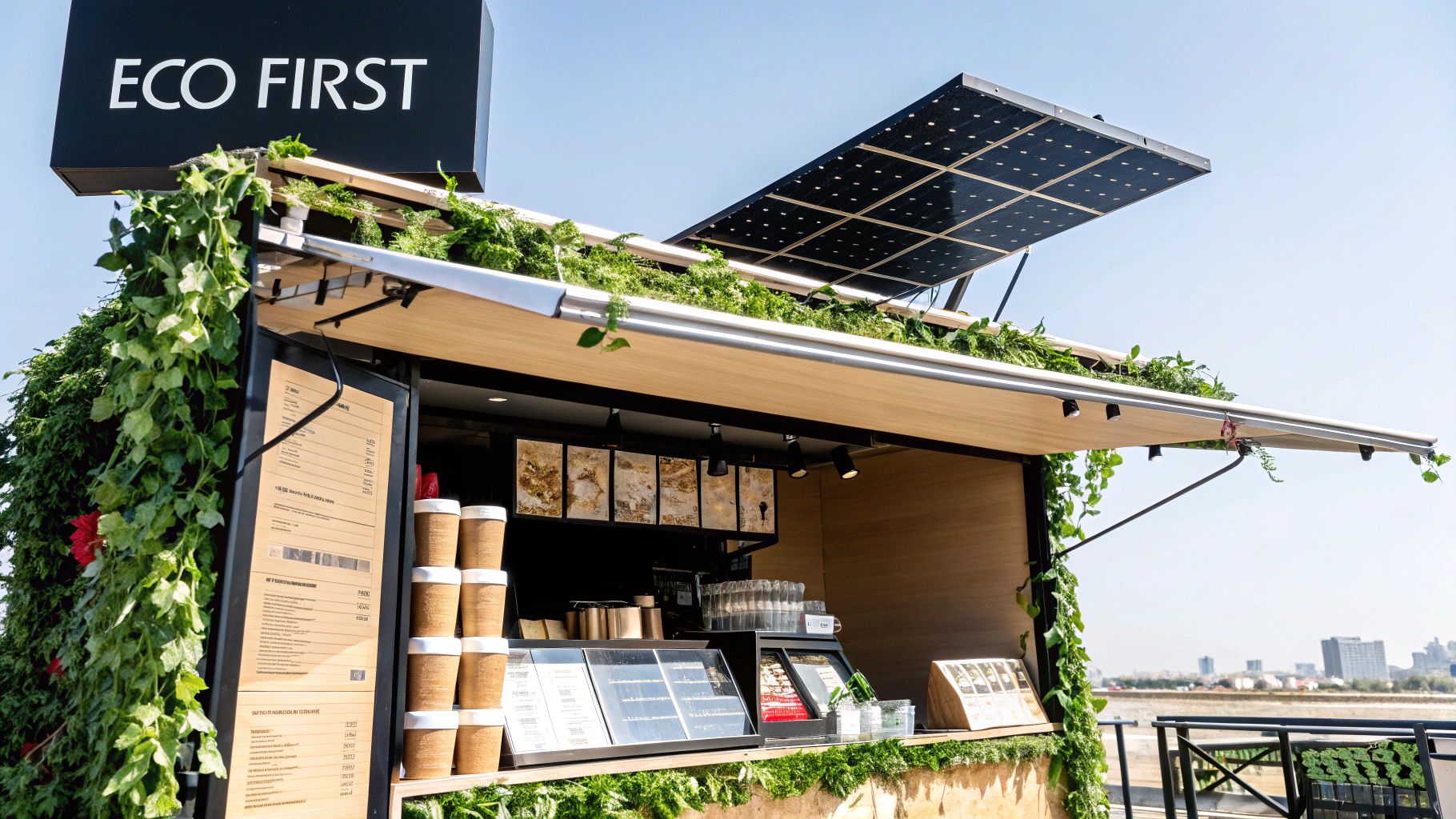
10 Profitable Concession Stand Ideas for 2025
Share
The classic concession stand is evolving. Gone are the days of limited menus and long lines being the only option for event-goers. Today's most successful ventures blend creative culinary concepts with smart technology and unforgettable customer experiences, transforming a simple snack booth into a must-visit destination. This shift requires more than just a new menu; it demands a strategic approach to equipment, layout, and service delivery.
Whether you're launching a new business or upgrading an existing one, the right concession stand ideas can significantly boost profitability and set you apart. Efficient operations often start with the right foundation, such as versatile stainless steel prep tables that can handle high volume, or specialized units like pizza and sandwich prep tables that streamline specific workflows. This guide explores 10 forward-thinking concepts designed to capture modern audiences. We'll cover everything from interactive mobile food trucks and self-service micro-markets to nostalgia-themed pop-ups and sustainable operations. Each idea provides a practical blueprint to help you thrive in the dynamic world of event food service, offering actionable insights to reinvent your counter and maximize your impact.
1. Interactive Mobile Food Trucks
Stepping far beyond the traditional hot dog cart, interactive mobile food trucks are a dynamic and modern approach to concession stand ideas. Pioneered by innovators like Roy Choi of Kogi BBQ, these rolling restaurants leverage mobility, high-quality niche menus, and technology to create a unique customer experience. Instead of waiting for customers to come to them, food trucks go where the people are: festivals, office parks, and local neighborhood hotspots.
This model thrives on creating a buzz and a loyal following. Success stories like The Halal Guys and Nashville's Grilled Cheeserie demonstrate the power of a focused menu with a few stellar signature items. This strategy simplifies inventory and operations while building a strong brand identity. Effective social media use is non-negotiable, allowing trucks to announce locations in real-time and engage directly with their customer base.
The following infographic highlights the core components that define the modern food truck model.

This visual breakdown shows how a higher initial investment in a vehicle is balanced by lower overhead and enhanced by strategic technology and mobility. Equipping these mobile kitchens requires careful planning, from standard stainless steel prep tables to specialized pizza and sandwich prep tables that optimize a small space for high-volume service. For a detailed guide on outfitting your mobile unit, you can explore the various types of food truck kitchen equipment available. This approach is ideal for entrepreneurs seeking flexibility and direct customer interaction.
2. Self-Service Micro Markets
Transforming the traditional vending concept, self-service micro markets are a sophisticated and automated concession stand idea. Pioneered by companies like Amazon and Aramark, these unattended retail spaces function like miniature convenience stores, offering a wide array of fresh foods, snacks, and beverages. They operate 24/7 with minimal staffing, relying on self-checkout kiosks and cashless payment systems to provide a seamless customer experience in high-traffic, captive audience environments like office buildings, hospitals, and university campuses.
This model capitalizes on convenience and data-driven inventory management. Success stories like Amazon Go and Byte Foods demonstrate the power of technology to meet consumer demand for immediate, quality options. By analyzing sales data, operators can tailor their product selection to the specific preferences of the location's demographic, ensuring high turnover and minimal waste. This data-first approach simplifies operations and maximizes profitability, making it one of the most innovative concession stand ideas for modern venues.
The following infographic illustrates the key operational components of a self-service micro market.
This visual breakdown shows how a higher initial investment in technology and security is offset by drastically reduced labor costs and the potential for round-the-clock revenue. Setting up the central commissary where food is prepared for these markets is crucial and requires efficient equipment. Standard stainless steel prep tables are essential for general food handling, while specialized units like pizza and sandwich prep tables with refrigerated compartments are vital for assembling fresh, ready-to-eat meals. This approach is perfect for operators targeting locations that demand constant access and variety.
3. Experiential Pop-Up Concession Stands
Experiential pop-up concession stands transform the simple act of buying food into a memorable, immersive event. This innovative approach, popularized by brands like the Museum of Ice Cream and Refinery29's 29Rooms, focuses on creating temporary, themed environments that are as much an attraction as the menu itself. These stands are designed to be highly visual and shareable, turning customers into organic marketers through social media.
This model is less about a permanent location and more about creating a temporary, high-impact "moment." Success stories often involve collaborations, like Netflix creating themed food experiences for show launches, or seasonal holiday markets that draw crowds with unique aesthetics and limited-time offerings. The core strategy is to merge food service with entertainment, creating an Instagram-worthy destination that generates significant buzz and drives foot traffic through its novelty and exclusivity.

This visual-first approach demands meticulous planning, from securing high-traffic temporary locations to designing a compelling theme. The menu should complement the experience, with uniquely presented items that encourage photos. The operational setup, though temporary, must be efficient. Outfitting these spaces often involves versatile equipment that can be easily transported and set up, such as various types of stainless steel prep tables. For menus requiring specific assembly lines, specialized units like pizza prep tables and sandwich prep tables are essential for maintaining quality and speed in a high-demand, temporary environment. This is one of the most effective concession stand ideas for brands looking to create a powerful, short-term marketing impact.
4. Healthy & Dietary-Specific Menu Focus
Moving away from traditional deep-fried fare, a health-conscious menu is one of the most relevant modern concession stand ideas. This concept caters directly to the growing consumer demand for wholesome and dietary-specific options. By specializing in vegan, gluten-free, keto, or organic choices, a concession stand can capture a dedicated and often underserved market segment at events, stadiums, and festivals.
This model is built on transparency and quality ingredients. Success stories like Sweetgreen's stadium partnerships and the principles seen in Whole Foods Market demonstrate that consumers will pay a premium for food that aligns with their wellness goals. The key is to offer delicious, satisfying alternatives to typical concession food, proving that healthy can also be convenient and crave-worthy. This approach builds a reputation for care and quality, attracting a loyal clientele.
A key to success lies in clearly communicating your offerings and sourcing. Display certifications prominently and train staff to confidently answer questions about ingredients and dietary restrictions. Partnering with local organic farms can enhance your brand's story and appeal. To manage a diverse menu of fresh ingredients, an organized prep area is essential. Using a combination of standard stainless steel prep tables for general chopping and specialized sandwich prep tables with refrigerated compartments keeps ingredients fresh, organized, and easily accessible, ensuring both speed and food safety. This focus is ideal for venues looking to modernize their offerings and appeal to a broader, more health-aware audience.
5. Technology-Enhanced Ordering Systems
Moving away from long lines and manual order-taking, technology-enhanced ordering systems represent a significant upgrade for modern concession stand ideas. Pioneered by giants like Starbucks and McDonald's, this approach integrates mobile apps, QR code menus, and self-service kiosks to streamline the entire customer journey. Instead of waiting in a queue to place and pay for an order, customers can do so from their phones or a dedicated terminal, reducing wait times and improving order accuracy.
This model is built on efficiency and customer convenience. Success stories from major chains like Domino's Pizza and large venues with stadium-specific ordering apps show the power of letting technology handle the transactional part of the experience. This frees up staff to focus on food preparation and fulfillment. A key benefit is the ability to handle high-volume rushes during peak times, such as halftime at a game, without creating bottlenecks at the counter.
Implementing this system requires a thoughtful approach to both technology and workflow. For example, the kitchen layout must be optimized for a new kind of order flow, where digital tickets replace verbal commands. This often involves creating dedicated zones for different tasks, using durable surfaces like stainless steel prep tables for assembly, and specialized equipment like pizza prep tables or sandwich prep tables to keep ingredients organized and chilled. To discover how a well-organized workspace complements new technology, you can find strategies on how to improve workplace efficiency. This method is ideal for high-traffic locations seeking to maximize throughput and enhance the customer experience.
6. Local Artisan & Craft Product Partnerships
Shifting away from mass-produced snacks, this concession stand idea focuses on creating a curated, hyper-local experience by partnering with area artisans and craft producers. This approach transforms a simple stand into a showcase for regional flavor, offering unique products that customers can't find anywhere else. Inspired by the vendor collaborations seen at places like Seattle's Pike Place Market and the craft brewery movement, this model builds a strong sense of community and authenticity.
This strategy thrives on storytelling and quality. Success hinges on sourcing high-demand local products, such as craft beers, small-batch baked goods, or artisanal cheeses, and presenting them to a wider audience. This not only elevates the concession stand's menu but also supports other local businesses, creating a symbiotic relationship. Offering a rotating menu of featured partners keeps the selection fresh and encourages repeat visits from customers eager to try the next local specialty.
A key benefit of this model is the ability to offer premium, exclusive items that command higher price points while fostering community goodwill. Effectively showcasing these products requires a well-organized prep area. Using a combination of standard stainless steel prep tables for general use alongside more specialized units can optimize workflow. For instance, a dedicated sandwich prep table with refrigerated wells is perfect for assembling gourmet sandwiches with local cheeses and charcuterie, keeping ingredients fresh and accessible. For more details on choosing the right equipment, you can learn about the different types of stainless steel prep tables available. This approach is ideal for venues wanting to create a memorable, premium experience that reflects local character.
7. Entertainment-Integrated Concession Experiences
Transforming the simple act of buying food into a memorable event, entertainment-integrated concession experiences are one of the most engaging concession stand ideas. This model elevates the customer experience by incorporating live performances, cooking demonstrations, or interactive games directly into the purchasing process. Instead of passively waiting in line, customers become part of a show, making their time at the concession stand a highlight of the event.
This concept thrives on creating an immersive atmosphere that captivates an audience. Success stories like the dinner-and-a-show model of Medieval Times or the culinary theatrics of Benihana demonstrate how entertainment can be woven into the dining experience to build a powerful brand and justify premium pricing. The goal is to make the concession stand a destination in itself, not just a place to get food. This approach is perfect for venues with long wait times or for operators looking to stand out in a crowded marketplace.
Integrating entertainment requires more than just a performance; it demands a thoughtfully designed space. The layout must support both the show and efficient service. For example, a "Benihana-style" teppanyaki grill station where chefs cook in front of customers needs a dedicated performance area that is also a functional kitchen. This setup often involves specialized equipment, such as durable stainless steel prep tables for chopping and staging ingredients, and dedicated sandwich prep tables that keep toppings chilled and accessible for rapid, made-to-order service. The key is to design a workflow that is both a spectacle and a highly efficient food production line.
8. Sustainable & Eco-Friendly Operations
Adopting an eco-friendly model is one of the most forward-thinking concession stand ideas, meeting a growing consumer demand for environmental responsibility. This approach goes beyond simply recycling; it involves a holistic commitment to sustainability across the entire operation. This includes using compostable packaging, implementing waste reduction systems, sourcing ingredients from local, sustainable farms, and even utilizing renewable energy sources like solar panels. Brands like Patagonia Provisions have championed this by building their entire food model around regenerative agriculture and responsible sourcing.

The success of this model hinges on authenticity and clear communication. Businesses like Ben & Jerry's and Whole Foods Market have built strong customer loyalty by transparently sharing their sustainability efforts. This strategy not only attracts environmentally conscious consumers but also enhances brand reputation and can lead to operational efficiencies, such as reduced waste disposal costs. Implementing these practices requires careful planning, from partnering with certified suppliers to educating staff and customers about the importance of your eco-friendly choices.
Choosing durable, long-lasting equipment is a key component of a sustainable operation, reducing waste and replacement frequency. High-quality stainless steel prep tables are foundational, offering longevity and easy sanitation. For specialized menus, units like pizza prep tables or sandwich prep tables with refrigerated compartments help minimize food spoilage by keeping ingredients at optimal temperatures. This smart equipment strategy supports waste reduction goals while ensuring food safety and efficiency. To explore equipment that aligns with a sustainable model, you can review various types of durable stainless steel work tables. This approach is ideal for businesses aiming to build a modern, responsible brand identity that resonates with today's consumers.
9. Nostalgia-Themed Retro Concessions
Tapping into the powerful emotion of nostalgia, retro-themed concessions recreate the classic American experience with vintage aesthetics and time-honored recipes. This approach transports customers to a different era, transforming a simple purchase into a memorable event. By curating a specific historical feel, such as a 1950s drive-in or a classic carnival stand, you offer more than just food; you provide an immersive atmosphere that encourages social sharing and builds a unique brand identity.
This model's success lies in its authenticity and attention to detail. Chains like Sonic Drive-In and the retail stores of Cracker Barrel have masterfully built empires on this concept, proving its lasting appeal. Similarly, Disney's retro-themed venues demonstrate how a deep commitment to a historical theme can create a powerful customer draw. The key is to balance a vintage look with modern operational efficiency and food safety standards, creating one of the more engaging concession stand ideas.
Authentic decor, period-appropriate staff uniforms, and a menu of classic favorites like milkshakes, corn dogs, and popcorn in vintage-style containers are essential. This strategy thrives at car shows, community fairs, and themed events where a sense of history enhances the overall experience. The setup itself becomes a major attraction and a prime photo opportunity for visitors.
To execute this concept effectively, the right equipment is crucial for both aesthetic and function. A gleaming stainless steel prep table provides a durable, easy-to-clean surface that fits the classic diner look while meeting health codes. For more specialized menus, a sandwich prep table with refrigerated compartments keeps ingredients fresh and organized, perfect for crafting classic deli sandwiches. This nostalgic approach is ideal for operators looking to create a distinct and highly marketable brand.
10. Multi-Vendor Food Hall Concepts
Transforming the traditional concession stand into a destination, multi-vendor food hall concepts consolidate several specialized vendors under one roof. This model, popularized by destinations like Chelsea Market in New York and various Time Out Market locations, offers a diverse, market-style dining atmosphere. Instead of a single menu, customers can explore a curated collection of culinary options, creating a more engaging and social experience.
This approach amplifies customer draw by catering to varied tastes and preferences simultaneously. Success hinges on a well-curated mix of complementary, non-competing vendors and a unified operational framework. Creating a cohesive brand identity for the hall while allowing individual vendors to shine is key. This model thrives in high-traffic venues like stadiums, large event spaces, or community hubs, turning a simple food break into a memorable culinary event.
The following infographic highlights the key elements of a successful multi-vendor food hall.
This visual shows how the model leverages shared infrastructure and marketing to benefit all participating vendors. Equipping these individual stalls requires smart space utilization with versatile equipment, from standard stainless steel prep tables to specialized pizza prep tables and sandwich prep tables that streamline specific workflows. For a closer look at outfitting these diverse kitchen spaces, you can find a comprehensive guide on the types of commercial kitchen equipment available. This is an ideal solution for operators looking to maximize variety and sales potential in a large-scale setting.
10 Concession Stand Concepts Comparison
| Concept | Implementation Complexity 🔄 | Resource Requirements ⚡ | Expected Outcomes 📊 | Ideal Use Cases 💡 | Key Advantages ⭐ |
|---|---|---|---|---|---|
| Interactive Mobile Food Trucks | Medium – vehicle investment & permits needed | Moderate – vehicle, tech, and staff | High mobility and customer reach | Outdoor events, diverse locations | Flexible reach, built-in marketing appeal |
| Self-Service Micro Markets | High – tech installation and maintenance | High – technology and security systems | 24/7 availability, labor cost reduction | Offices, campuses, high-traffic indoor areas | Continuous sales, minimal staffing |
| Experiential Pop-Up Concession Stands | High – design, setup, and event planning | Moderate to High – decor, staff, and logistics | High social media engagement, buzz creation | Seasonal/limited events, brand promotion | Creates urgency, premium pricing |
| Healthy & Dietary-Specific Menu Focus | Medium – ingredient sourcing and staff training | Moderate – specialty ingredients and training | Loyal health-conscious customer base | Health-aware venues, wellness-focused events | Market differentiation, premium pricing |
| Technology-Enhanced Ordering Systems | High – software, hardware, and connectivity setup | High – app development, maintenance, and support | Reduced wait times, operational efficiency | Stadiums, cafes, high-volume concession stands | Higher order accuracy, valuable customer data |
| Local Artisan & Craft Partnerships | Medium – supplier coordination and relationship management | Moderate – sourcing and marketing materials | Unique offerings, strong community ties | Farmers markets, local events, craft-focused venues | Unique products, strong storytelling |
| Entertainment-Integrated Experiences | High – added entertainment logistics and staffing | High – performers, equipment, and coordination | Increased dwell time, enhanced customer experience | Family venues, large events, casual dining spaces | Enhanced engagement, premium pricing |
| Sustainable & Eco-Friendly Operations | Medium to High – sourcing & eco-system setup | Moderate to High – sustainable materials & energy | Positive brand image, appeal to eco-conscious customers | Green events, eco-markets, corporate responsibility | Cost savings, strong environmental appeal |
| Nostalgia-Themed Retro Concessions | Medium – vintage decor and recipe authenticity | Moderate – specialized equipment and training | Emotional connection and cross-generational appeal | Theme parks, retro festivals, nostalgic events | Unique visual appeal, premium authentic experience |
| Multi-Vendor Food Hall Concepts | High – vendor coordination and facility management | High – multiple vendors, shared infrastructure | Diverse customer base, social dining atmosphere | Urban food markets, large venues, community hubs | Shared costs, variety, cross-promotion |
Building Your Concession Stand: The Foundation of Success
Transforming a simple idea into a thriving concession stand business requires more than just a great menu. As we've explored, the most successful ventures today are those that combine creativity with operational excellence. From the mobility of food trucks and the convenience of micro-markets to the unique charm of nostalgia-themed pop-ups and the community focus of local artisan partnerships, the possibilities are vast. The key is to select a concept that aligns with your brand, excites your target audience, and fits the unique context of your event or location.
However, the true engine of profitability lies in your execution. An experiential pop-up or a health-focused menu can only succeed if your back-of-house operations are streamlined, efficient, and sanitary. This is where the foundational elements of your setup, particularly your food preparation surfaces, become critically important. An investment in the right equipment is an investment in your ability to consistently deliver quality products, manage high-volume demands, and maintain impeccable food safety standards. These are the non-negotiable pillars that support even the most creative concession stand ideas.
The Critical Role of Professional Prep Tables
Your choice of prep table is a direct reflection of your operational strategy. A well-organized, durable, and hygienic workspace is the starting point for every item you sell. When building out your concession stand, consider the specific needs of your menu to select the most effective equipment. Stainless steel is the industry standard for its durability, resistance to corrosion, and ease of sanitation. Here are several types of stainless steel prep tables available:
- Standard Stainless Steel Work Tables: These are the versatile workhorses of any kitchen. They provide a simple, flat, easy-to-clean surface ideal for general prep, plating, and assembling non-refrigerated items. Look for models with an undershelf to maximize your storage footprint, a crucial feature in compact concession spaces.
- Tables with Backsplashes: For stations where mixing, chopping, or saucing occurs, a table with an integrated backsplash is invaluable. It helps contain splashes and spills, protecting your walls and making cleanup significantly faster and more thorough.
- Sandwich Prep Tables: These specialized units are essential for any concession stand selling sandwiches, wraps, or salads. A sandwich prep table combines a cutting board work surface with a refrigerated rail on top that holds multiple food pans. This keeps ingredients like meats, cheeses, and vegetables chilled and within arm's reach, drastically speeding up assembly time while ensuring food safety.
- Pizza Prep Tables: Similar to sandwich tables, a pizza prep table is designed for high-volume pizza production. It features a wide, refrigerated rail for toppings and often a larger, chilled work surface made of marble or stainless steel to keep dough from sticking. This all-in-one station streamlines the entire pizza-making process, from saucing to topping.
By carefully selecting professional-grade equipment, you are not just buying a piece of metal; you are designing a workflow. The right stainless steel prep table reduces cross-contamination risks, withstands the rigors of a fast-paced environment, and empowers your staff to work more efficiently. This operational backbone ensures your innovative concession stand ideas are built on a foundation of quality, safety, and long-term success.
Ready to build the operational core of your next venture? Explore a comprehensive selection of NSF-certified stainless steel work tables, sandwich prep stations, and pizza prep tables at PrepTables.com. Find the perfect foundation for your concession stand ideas and ensure your setup is built for efficiency and durability from day one at PrepTables.com.
